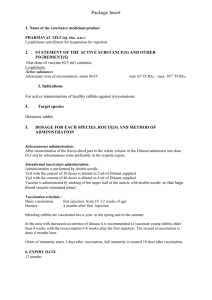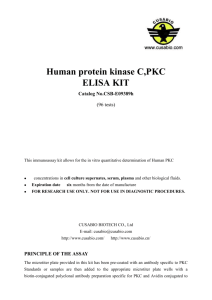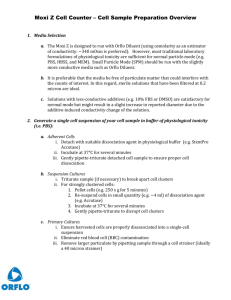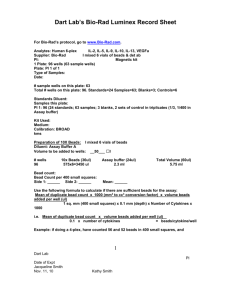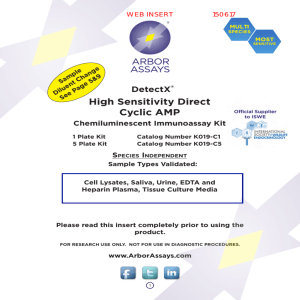High Sensitivity Direct Cyclic AMP
advertisement
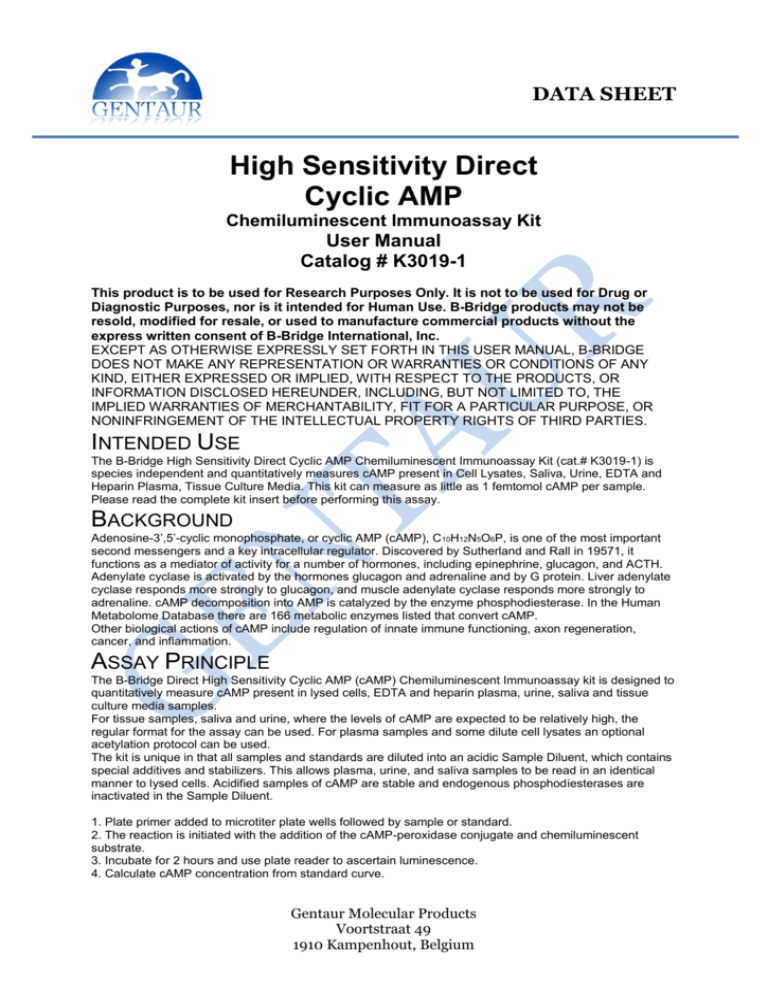
DATA SHEET High Sensitivity Direct Cyclic AMP Chemiluminescent Immunoassay Kit User Manual Catalog # K3019-1 This product is to be used for Research Purposes Only. It is not to be used for Drug or Diagnostic Purposes, nor is it intended for Human Use. B-Bridge products may not be resold, modified for resale, or used to manufacture commercial products without the express written consent of B-Bridge International, Inc. EXCEPT AS OTHERWISE EXPRESSLY SET FORTH IN THIS USER MANUAL, B-BRIDGE DOES NOT MAKE ANY REPRESENTATION OR WARRANTIES OR CONDITIONS OF ANY KIND, EITHER EXPRESSED OR IMPLIED, WITH RESPECT TO THE PRODUCTS, OR INFORMATION DISCLOSED HEREUNDER, INCLUDING, BUT NOT LIMITED TO, THE IMPLIED WARRANTIES OF MERCHANTABILITY, FIT FOR A PARTICULAR PURPOSE, OR NONINFRINGEMENT OF THE INTELLECTUAL PROPERTY RIGHTS OF THIRD PARTIES. INTENDED USE The B-Bridge High Sensitivity Direct Cyclic AMP Chemiluminescent Immunoassay Kit (cat.# K3019-1) is species independent and quantitatively measures cAMP present in Cell Lysates, Saliva, Urine, EDTA and Heparin Plasma, Tissue Culture Media. This kit can measure as little as 1 femtomol cAMP per sample. Please read the complete kit insert before performing this assay. BACKGROUND Adenosine-3’,5’-cyclic monophosphate, or cyclic AMP (cAMP), C10H12N5O6P, is one of the most important second messengers and a key intracellular regulator. Discovered by Sutherland and Rall in 19571, it functions as a mediator of activity for a number of hormones, including epinephrine, glucagon, and ACTH. Adenylate cyclase is activated by the hormones glucagon and adrenaline and by G protein. Liver adenylate cyclase responds more strongly to glucagon, and muscle adenylate cyclase responds more strongly to adrenaline. cAMP decomposition into AMP is catalyzed by the enzyme phosphodiesterase. In the Human Metabolome Database there are 166 metabolic enzymes listed that convert cAMP. Other biological actions of cAMP include regulation of innate immune functioning, axon regeneration, cancer, and inflammation. ASSAY PRINCIPLE The B-Bridge Direct High Sensitivity Cyclic AMP (cAMP) Chemiluminescent Immunoassay kit is designed to quantitatively measure cAMP present in lysed cells, EDTA and heparin plasma, urine, saliva and tissue culture media samples. For tissue samples, saliva and urine, where the levels of cAMP are expected to be relatively high, the regular format for the assay can be used. For plasma samples and some dilute cell lysates an optional acetylation protocol can be used. The kit is unique in that all samples and standards are diluted into an acidic Sample Diluent, which contains special additives and stabilizers. This allows plasma, urine, and saliva samples to be read in an identical manner to lysed cells. Acidified samples of cAMP are stable and endogenous phosphodiesterases are inactivated in the Sample Diluent. 1. Plate primer added to microtiter plate wells followed by sample or standard. 2. The reaction is initiated with the addition of the cAMP-peroxidase conjugate and chemiluminescent substrate. 3. Incubate for 2 hours and use plate reader to ascertain luminescence. 4. Calculate cAMP concentration from standard curve. Gentaur Molecular Products Voortstraat 49 1910 Kampenhout, Belgium KIT COMPONENTS Coated white 96-well plate 1 plate Cyclic AMP Standard (1,500 pmol/mL) 125 uL - Outer container has formaldehyde-absorbing pad; keep tightly sealed Cyclic AMP Antibody 3.0 mL 50X Cyclic AMP Conjugate Concentrate 60 uL Conjugate Diluent 3.0 mL Sample Diluent 28 mL Plate Primer 5.0 mL Acetic Anhydride 2.0 mL - WARNING: Corrosive Lachrymator Triethylamine 4.0 mL - WARNING: Corrosive Lachrymator 20X Wash Buffer Concentrate 30 mL Substrate Solution A 6.0 mL Substrate Solution B 6.0 mL Plate Sealer 1 each Store all components at 4°C MATERIALS REQUIRED BUT NOT SUPPLIED - Deionized or distilled water - Microplate Shaker - Glass test tubes - 96-well plate reader capable of reading glow chemiluminescence - Software for converting raw relative light unit (RLU) readings from the plate reader and carrying out four parameter logistic curve (4PLC) fitting PRECAUTIONS As with all such products, this kit should only be used by qualified personnel who have had laboratory safety instruction. The complete insert should be read and understood before attempting to use the product. This kit utilizes a peroxidase-based readout system. Buffers, including other manufacturers Wash Buffers, containing sodium azide will inhibit color production from the enzyme. Make sure all buffers used for samples are azide free. Ensure that any plate washing system is rinsed well with deionized water prior to using the supplied Wash Buffer. The supplied Sample Diluent and Sample Diluent Concentrate are acidic. The Stop Solution is 1M HCl. These solutions should not come in contact with skin or eyes. Take appropriate precautions when handling these reagents. The kit uses acetic anhydride and triethylamine as acetylation reagents. Triethylamine and acetic anhydride are lachrymators. Caution - corrosive, flammable, and harmful vapor. Use in hood with proper ventilation and wear appropriate protective safety wear. In all cases, please consult your institution’s safety procedures for working with hazardous chemicals. SAMPLE PREPARATION This assay has been validated for saliva, urine, serum, EDTA and heparin plasma samples and for tissue culture samples. A general cyclooxygenase inhibitor, such as meclofenamic acid or indomethacin at 15 μM should be added immediately after collection of any biological samples, such as serum and plasma. All samples should be frozen rapidly in dry ice/ethanol and stored at -80°C. Samples containing visible particulate should be centrifuged prior to using. Severely hemolyzed samples should not be used in this kit. All samples containing lipids may interfere with the measurement of PGE2. Samples containing high lipid content may be extracted as described below. A useful online resource for the extraction of bioactive lipids can be found at: http://lipidlibrary.aocs.org/topics/spe_alm/index.htm#ext Cells Cell lysis buffers containing high concentrations of SDS or other detergents may not be compatible with this assay or may require extra dilution. Please read Interferents section on page 22 for more information. This kit is compatible with either adherent or non-adherent cells. The cells can be grown in any suitable sterile containers such as Petri dishes, 12-, 48- or 96-well culture plates or flasks. The cells must be isolated from the media prior to being lysed with the provided Sample Diluent. The acidic Sample Diluent contains detergents to lyse the cells, inactivate endogenous phosphodiesterases and stabilize the cAMP. Some cell types are extremely hardy and the end user should optimize the lysis conditions utilizing freeze-thaw cycles Gentaur Molecular Products Voortstraat 49 1910 Kampenhout, Belgium and ultrasonic treatments to fully lyse their cells. For adherent cells, the media should be aspirated from the cells and the cells washed with PBS. The adherent cells should be treated directly with the Sample Diluent for 10 minutes at room temperature. Cells can be scraped to dislodge them from the plate surface and cells should be inspected to ensure lysis. Detergent has been added to the Sample Diluent to help lysis occur. Centrifuge the samples at _ 600 x g at 4°C for 15 minutes and assay the supernatant directly. If required, the TCM can be assayed for cAMP as outlined below. For non-adherent cells, pellet and wash the cells with PBS by centrifuging the samples at _ 600 x g at 4°C for 15 minutes as described above. Treat the aspirated, washed pellet directly with the Sample Diluent for 10 minutes at room temperature. Cells should be inspected to ensure lysis. Detergent has been added to the Sample Diluent to help lysis occur. Centrifuge the samples at _ 600 x g at 4 °C for 15 minutes and assay the supernatant directly. If required, the TCM can be assayed for cAMP as outlined below. Tissue Samples Tissues samples should be frozen in liquid nitrogen and stored at -80°C if analysis is not to be carried out immediately. Grind the frozen tissue in a stainless steel mortar under liquid nitrogen until it is a fine powder. Allow the liquid nitrogen to evaporate and weigh the powdered tissue. Add 1 mL of Sample Diluent for every 100 mg of tissue. Incubate in the Sample Diluent for 10 minutes on ice, and then centrifuge at _600 x g at 4°C for 15 minutes. Collect the supernatant and run in the assay immediately or store frozen at _ -70°C. For samples that require concentration and delipidation, a trichloroacetic acid (TCA)/ether protocol can be used. Grind the frozen tissue in a stainless steel mortar under liquid nitrogen until it is a fine powder. Allow the liquid nitrogen to evaporate and weigh the powdered tissue. Add 1 mL of ice cold 5% TCA (weight/volume) for every 100 mg of tissue and grind in a glass-Teflon mortar. Incubate in the TCA for 10 minutes on ice, and then centrifuge at _600 x g at 4°C for 15 minutes. Collect the supernatant. For every 1 mL of TCA supernatant add 3 mL of water saturated diethyl ether* and shake in a glass vial. Allow the ether to separate as the top layer, remove it and discard the ether. Dry the aqueous layer by lyophilization or using a vacuum centrifuge. Reconstitute by adding 1 mL of Sample Diluent for every mL of 5% TCA used to extract and run in the assay immediately or store at _ -70°C. Diethyl ether is extremely flammable and should be used in a hood. Tissue Culture Media For measuring cAMP in tissue culture media (TCM), samples should be read off a standard curve generated in TCM. Samples may need to be diluted further in TCM. Plasma Samples Plasma samples should be diluted _ 1:10 with the supplied Sample Diluent and acetylated prior to running in the Acetylated Format assay Urine Samples Urine samples should be diluted _ 1:20 with the supplied Sample Diluent prior running in the assay. Due to the high concentration of cAMP in urine, samples may need to be diluted further. Saliva Samples Saliva samples should be diluted _ 1:4 with the supplied Sample Diluent prior running in the assay.. Use all samples within 2 hours of dilution in Sample Diluent. REGULAR FORMAT ASSAY Use this format for urine, saliva and some cell lysates. Do NOT use for plasma samples. REGULAR FORMAT REAGENT PREPARATION Allow the kit reagents to come to room temperature for 30-60 minutes. We recommend that all standards and samples be run in for accurate determination of cAMP concentrations. Ensure that all samples have reached room temperature and have been diluted as appropriate prior to running them in the kit. Wash Buffer Dilute Wash Buffer Concentrate 1:20 by adding one part of the concentrate to nineteen parts of deionized water. Once diluted this is stable at room temperature for 3 months. Cyclic AMP Conjugate Concentrate The supplied Cyclic AMP Conjugate Concentrate should be diluted 1:50 with the Conjugate Diluent (50 uL Conjugate Concentrate with 2.45 mL of Conjugate Diluent for a total solution volume of 2.5 mL) Once diluted the Cyclic AMP conjugate is stable for one month when stored at 4°C. Gentaur Molecular Products Voortstraat 49 1910 Kampenhout, Belgium Chemiluminescent Substrate Mix one part of the Substrate Solution A with one part of Substrate Solution B in a brown bottle. Once mixed the substrate is stable for one month when stored at 4°C. Standard Preparation 1. Label one glass test tube as Working Stock and five tubes as #1 through #5. 2. Pipet 90 μL of Sample Diluent into the Stock 2 tube and 450 μL of Sample Diluent into tube #1. 3. Pipet 300 μL of Sample Diluent into tubes #2 to #5. 4. The Cyclic AMP stock solution contains an organic solvent. Prerinse the pipet tip several times to ensure accurate delivery. Carefully add 10 μL of the cAMP stock solution to the Working Stock tube and vortex completely. 5. Take 50 μL of the cAMP solution in the Working Stock tube and add it to tube #1 and vortex completely. 6. Take 150 μL of the cAMP solution in tube #1 and add it to tube #2 and vortex completely. 7. Repeat the serial dilutions for tubes #3 through #5. The concentration of Cyclic AMP in tubes 1 through 5 will be 15, 5, 1.667, 0.556, and 0.185 pmol/mL. Use all Standards within 1 hour of preparation. REGULAR FORMAT ASSAY PROTOCOL 1. Add 50 μL of Plate Primer into all wells used. Failure to Add Plate Primer to ALL Wells First Will Cause Assay To Fail. 2. Pipet 75 μL Sample Diluent into the non-specific binding (NSB) wells. 3. Pipet 50 μL of Sample Diluent into wells to act as maximum binding wells (B0 or 0 pg/mL). 4. Pipet 50 μL of samples or standards into wells in the plate. NOTE: Sample Diluent will turn from orange to bright pink upon sample or standard addition to the Plate Primer in the wells. 5. Add 25 μL of the diluted cAMP Conjugate to each well using a repeater or multichannel pipet. 6. Add 25 μL of the cAMP Antibody to each well, except the NSB wells, using a repeater or multichannel pipet. 7. Gently tap the sides of the plate to ensure adequate mixing of the reagents. Cover the plate with the plate sealer and shake at room temperature for 2 hours. If the plate is not shaken, signals bound will be approximately 25% lower. 8. Aspirate the plate and wash 4 times with the wash buffer. Tap the plate dry on absorbent towels. Add 100 μL of the mixed Chemiluminescent Substrate to each well, using a repeater or a multichannel pipet. 9. Immediately read the luminescence generated from each well in a mutimode or chemiluminescent plate reader using a 0.1 second read time per well. The chemiluminescent signal will decrease about 40% over 60 minutes. CALCULATIONS All luminometers read Relative Light Units (RLU). These RLU readings will vary with make or model of plate reader. Average the duplicate RLU readings for each standard and sample. Create a standard curve by reducing the data using the 4PLC fitting routine on the plate reader, after subtracting the mean RLU’s for the NSB. The sample concentrations obtained, calculated from the %B/B0 curve, should be multiplied by the dilution factor to obtain neat sample values. Gentaur Molecular Products Voortstraat 49 1910 Kampenhout, Belgium VALIDATION DATA Sensitivity and Limit of Detection Sensitivity was calculated by comparing the RLU’s for eighteen wells run for each of the B0 and standard #5. The detection limit was determined at two (2) standard deviations from the B0 along the standard curve. Sensitivity was determined as 0.119 pmol/mL. This is equivalent to 5.95 fmol cAMP per well. The Limit of Detection for the assay was determined in a similar manner by comparing the RLU’s for twenty runs for each of the zero standard and a low concentration human urine sample. Limit of Detection was determined as 0.076 pmol/mL. This is equivalent to 3.8 fmol cAMP per well. ACETYLATED ASSAY This format must be used for plasma, some cell lysates and any sample with low cAMP concentrations. Prior to running the acetylated assay, all standards, samples and the Sample Diluent used for the B0 and NSB wells must be acetylated. Acetylation is carried out by adding 15 μL of the Acetylation Reagent (as prepared below) for each 300 μL of the standard, sample and Sample Diluent. After addition of the Acetylation Reagent immediately vortex each treated standard, sample or Sample Diluent and use within 30 minutes of preparation. Note: Upon Acetylation, all of the standards and samples diluted in the orange Sample Diluent will change to a pale yellow color. ACETYLATED ASSAY REAGENT PREPARATION Allow the kit reagents to come to room temperature for 30-60 minutes. We recommend that all standards and samples be run in for accurate determination of cAMP concentrations. Ensure that all samples have reached room temperature and have been diluted as appropriate prior to running them in the kit. Gentaur Molecular Products Voortstraat 49 1910 Kampenhout, Belgium Wash Buffer Dilute Wash Buffer Concentrate 1:20 by adding one part of the concentrate to nineteen parts of deionized water. Once diluted this is stable at room temperature for 3 months. Cyclic AMP Conjugate Concentrate The supplied Cyclic AMP Conjugate Concentrate should be diluted 1:50 with the Conjugate Diluent (50 uL Conjugate Concentrate with 2.45 mL of Conjugate Diluent for a total solution volume of 2.5 mL) Once diluted the Cyclic AMP conjugate is stable for one month when stored at 4°C. Chemiluminescent Substrate Mix one part of the Substrate Solution A with one part of Substrate Solution B in a brown bottle. Once mixed the substrate is stable for one month when stored at 4°C. Acetylation Reagent Working in a fume hood mix one part of Acetic Anhydride with 2 parts of Triethylamine in a glass test tube. Use the following table to help determine the amount of Acetylation Reagent to make. Use the Acetylation Reagent within 1 hour of preparation. Standard Preparation All standards and samples should be diluted in glass test tubes. 1. Label eight glass test tubes as #1 through #8. Label one tube as Working Stock 2. Pipet 290 μL of Sample Diluent into the Working Stock tube. 3. Pipet 900 μL of Sample Diluent into tube #1 and 400 μL into tubes #2 to #8. 4. The Cyclic AMP stock solution contains an organic solvent. Prerinse the pipet tip several times to ensure accurate delivery. Carefully add 10 μL of the cAMP stock solution to the Working Stock tube and vortex completely. 5. Carefully add 100 μL of the Working Stock tube to tube #1 and vortex completely. 6. Take 400 μL of the cAMP solution in tube #1 and add it to tube #2 and vortex completely. 7. Repeat the serial dilutions for tubes #3 through #8. The concentration of Cyclic AMP in tubes 1 through 8 will be 5, 2.5, 1.25, 0.625, 0.313, 0.156, 0.078, and 0.039 pmol/mL. STANDARD AND SAMPLE ACETYLATION 1. Pipet 300 μL of Sample Diluent into a glass tube to act as the Zero standard/NSB tube. 2. Add 15 μL of Acetylation Reagent to this tube and vortex immediately. Proceed to assay within 30 minutes. 3. Pipet 300 μL of each standard and sample to be tested into glass tubes. 4. Add 15 μL of the Acetylation Reagent into each tube and vortex immediately. Proceed to assay within 30 minutes. NOTE: Samples and Sample Diluent will turn from orange to pale yellow upon acetylation. Gentaur Molecular Products Voortstraat 49 1910 Kampenhout, Belgium Use Acetylated Standards and Samples within 30 minutes of preparation ACETYLATED ASSSAY PROTOCOL 1. Add 50 μL of Plate Primer into all wells used. Failure To Add Plate Primer To ALL Wells First Will Cause Assay To Fail. 2. Pipet 75 μL acetylated Sample Diluent into the non-specific binding (NSB) wells. 3. Pipet 50 μL of acetylated Sample Diluent into wells to act as maximum binding wells (B0 or 0 pg/mL). 4. Pipet 50 μL of acetylated samples or standards into wells in the plate. 5. Add 25 μL of the diluted cAMP Conjugate to each well using a repeater or multichannel pipet. 6. Add 25 μL of the cAMP Antibody to each well, except the NSB wells, using a repeater or multichannel pipet. 7. Gently tap the sides of the plate to ensure adequate mixing of the reagents. Cover the plate with the plate sealer and shake at room temperature for 2 hours. If the plate is not shaken, signals bound will be approximately 25% lower. Note: Wells will turn from very pale yellow to pale pink during incubation. 8. Aspirate the plate and wash 4 times with the wash buffer. Tap the plate dry on absorbent towels. 9. Add 100 μL of the mixed Chemiluminescent Substrate to each well, using a repeater or multichannel pipet. 10. Immediately read the luminescence generated from each well in a mutimode or chemiluminescent plate reader using a 0.1 second read time per well. The chemiluminescent signal will decrease about 40% over 60 minutes. CALCULATIONS All luminometers read Relative Light Units (RLU). These RLU readings will vary with make or model of plate reader. Average the duplicate RLU readings for each standard and sample. Create a standard curve by reducing the data using the 4PLC fitting routine on the plate reader, after subtracting the mean RLU’s for the NSB. The sample concentrations obtained, calculated from the %B/B0 curve, should be multiplied by the dilution factor to obtain neat sample values Gentaur Molecular Products Voortstraat 49 1910 Kampenhout, Belgium VALIDATION DATA Sensitivity and Limit of Detection - Acetylated Sensitivity was calculated by comparing the RLU’s for eighteen wells run for each of the acetylated B0 and standard #8. The detection limit was determined at two (2) standard deviations from the B0 along the standard curve. Sensitivity was determined as 0.015 pmol/mL. This is equivalent to 0.75 fmol cAMP per sample. The Limit of Detection for the assay was determined in a similar manner by comparing the RLU’s for twenty runs for each of acetylated zero standard and a low concentration acetylated human sample. Limit of Detection was determined as 0.019 pmol/mL. This is equivalent to 0.95 fmol cAMP per sample. Gentaur Molecular Products Voortstraat 49 1910 Kampenhout, Belgium
